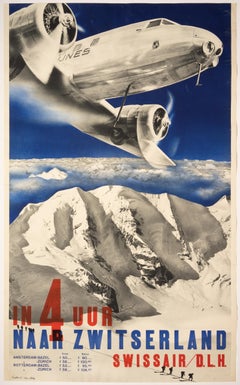Herbert Matter Vintage Airline Poster
Recent Sales
1930s Landscape Prints
Paper
Herbert Matter for sale on 1stDibs
Herbert Matter was a Swiss-born American photographer and graphic designer. He was born in Engelberg, on April 25, 1907. Matter studied painting at the École des Beaux-Arts in Geneva and the Académie Moderne in Paris with Fernand Léger and Amédée Ozenfant. He worked with Adolphe Mouron Cassandre, Le Corbusier and Deberny & Peignot. In 1932, he returned to Zürich, where he designed posters for the Swiss National Tourist Office and Swiss resorts. The travel posters won instant international acclaim for his pioneering use of photomontage combined with the typeface. He went to the United States in 1936 and was hired by legendary art director Alexey Brodovitch. He soon started working for Harper's Bazaar, Vogue and other magazines. In the 1940s, photographers, including Irving Penn, used Vogue’s studios at 480 Lexington Avenue for shooting the advertising work commissioned by outside clients. The practice was at first tolerated but by 1950 it was banned because it interfered with Vogue’s interests and was a severe handicap to their editorial operations. In response to this, Matter and three other Condé Nast photographers, Serge Balkin, Constantin Joffé and Geoffrey Baker left to establish Studio Enterprises Inc. in the former House & Garden studio on 37th Street. From 1946–66, Matter was a design consultant with Knoll Associates and worked closely with Charles and Ray Eames. From 1952–76, he was a professor of photography at Yale University and from 1958–68 he served as design consultant to Solomon R. Guggenheim Museum in New York and the Museum of Fine Arts in Houston. He was elected to the New York Art Directors Club Hall of Fame in 1977, received a Guggenheim Fellowship in photography in 1980 and the American Institute of Graphic Arts medal in 1983. As a photographer, Matter won acclaim for his purely visual approach. A master technician, he used every method available to achieve his vision of light, form and texture. Manipulation of the negative, retouching, cropping, enlarging and light drawing are some of the techniques he used to achieve the fresh form he sought in his still lifes, landscapes, nudes and portraits. As a filmmaker, he directed two films on his friend Alexander Calder, namely Sculptures and Constructions in 1944 and Works of Calder with music by John Cage for the Museum of Modern Art in 1950. Close friends of Matter and his wife Mercedes were the painters Jackson Pollock, Willem de Kooning, fellow Swiss photographer Robert Frank and Alberto Giacometti. Matter's wife Mercedes was the daughter of the American modernist painter Arthur Beecher Carles, and was herself the chief founder of the New York Studio School. “The absence of pomposity was characteristic of this guy”, said another designer, Paul Rand, about Matter. His creative life was devoted to narrowing the gap between the so-called fine and applied arts. Matter died on May 8, 1984, in Southampton, New York.
Finding the Right figurative-prints-works-on-paper for You
Bring energy and an array of welcome colors and textures into your space by decorating with figurative fine-art prints and works on paper.
Figurative art stands in contrast to abstract art, which is more expressive than representational. The oldest-known work of figurative art is a figurative painting — specifically, a rock painting of an animal made over 40,000 years ago in Borneo. This remnant of a remote past has long faded, but its depiction of a cattle-like creature in elegant ocher markings endures.
Since then, figurative art has evolved significantly as it continues to represent the world, including a breadth of works on paper, including printmaking. This includes woodcuts, which are a type of relief print with perennial popularity among collectors. The artist carves into a block and applies ink to the raised surface, which is then pressed onto paper. There are also planographic prints, which use metal plates, stones or other flat surfaces as their base. The artist will often draw on the surface with grease crayon and then apply ink to those markings. Lithographs are a common version of planographic prints.
Figurative art printmaking was especially popular during the height of the Pop art movement, and this kind of work can be seen in artist Andy Warhol’s extensive use of photographic silkscreen printing. Everyday objects, logos and scenes were given a unique twist, whether in the style of a comic strip or in the use of neon colors.
Explore an impressive collection of figurative art prints for sale on 1stDibs and read about how to arrange your wall art.
